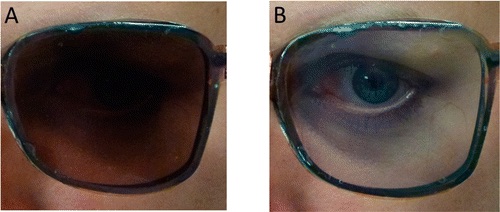[h=2]New Glasses Change Color on Demand[/h]By Alex B. Berezow - February 2, 2015
 Those of us who wear glasses have long been familiar with Transitions lenses, a type of lens that darkens in sunlight but is clear while indoors. The technology relies on a chemical phenomenon known as photochromism, in which molecules absorb a certain wavelength of light and change shape (that is, isomerize) in response. In the case of photochromic glasses, the lenses usually respond to UV light. That is why the lenses darken when exposed to the sun (which produces UV radiation), while they remain clear under artificial lights (which do not produce much UV light).
Those of us who wear glasses have long been familiar with Transitions lenses, a type of lens that darkens in sunlight but is clear while indoors. The technology relies on a chemical phenomenon known as photochromism, in which molecules absorb a certain wavelength of light and change shape (that is, isomerize) in response. In the case of photochromic glasses, the lenses usually respond to UV light. That is why the lenses darken when exposed to the sun (which produces UV radiation), while they remain clear under artificial lights (which do not produce much UV light).
The downside to photochromic lenses is that the chemical transition takes a long time. When going outdoors, the lenses darken in under 60 seconds, but the transition back to clear can take a few minutes. This is annoying. Also, photochromic lenses that respond to UV light often do not work inside automobiles because the windshield blocks UV light. Thus, a separate pair of sunglasses may be necessary for the car, which defeats the entire purpose of owning photochromic glasses in the first place.
Now, researchers from Georgia Tech, Clayton State, and BASF may have solved this decidedly First World problem. They have created electrochromic lenses that change color in response to a small voltage, simply by flipping the switch on a battery. Via a reversible electrochemical reaction, an oxidized and mainly clear polymer transforms into an electrically neutral and darkened polymer.
The best part? The lenses can switch between clear and dark within seconds. (See photos below.)

Furthermore, the authors suggest that, by using just a handful of electrochromic polymers, an entire palette of colors can be made. Moreover, they believe the lenses can be mass manufactured quickly and easily.
As a glasses wearer, I would purchase these in a heartbeat.
New Glasses Change Color on Demand | RealClearScience

The downside to photochromic lenses is that the chemical transition takes a long time. When going outdoors, the lenses darken in under 60 seconds, but the transition back to clear can take a few minutes. This is annoying. Also, photochromic lenses that respond to UV light often do not work inside automobiles because the windshield blocks UV light. Thus, a separate pair of sunglasses may be necessary for the car, which defeats the entire purpose of owning photochromic glasses in the first place.
Now, researchers from Georgia Tech, Clayton State, and BASF may have solved this decidedly First World problem. They have created electrochromic lenses that change color in response to a small voltage, simply by flipping the switch on a battery. Via a reversible electrochemical reaction, an oxidized and mainly clear polymer transforms into an electrically neutral and darkened polymer.
The best part? The lenses can switch between clear and dark within seconds. (See photos below.)

Furthermore, the authors suggest that, by using just a handful of electrochromic polymers, an entire palette of colors can be made. Moreover, they believe the lenses can be mass manufactured quickly and easily.
As a glasses wearer, I would purchase these in a heartbeat.
New Glasses Change Color on Demand | RealClearScience
